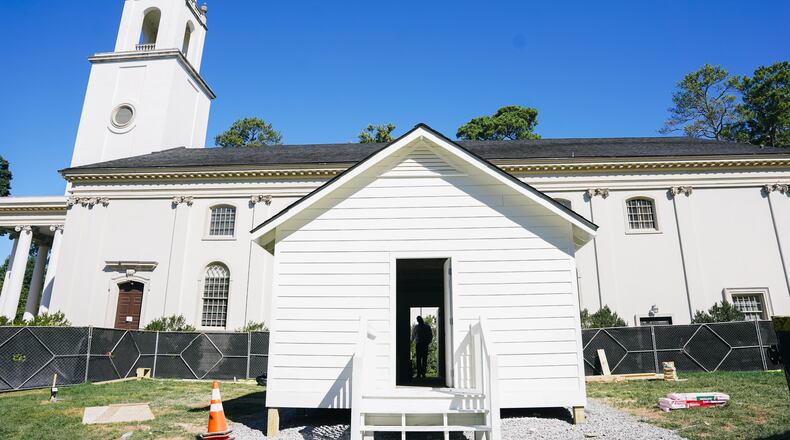Atlanta artist and activist Charmaine Minniefield has traveled around coastal Georgia and South Carolina and as far away as Gambia and Senegal to bring a piece of the African American religious narrative to life.
She is doing so in the form of a praise house, a place of worship and community gatherings originally used by enslaved Africans.
Her latest installation, a 22- by 26-foot wooden structure with a white wooden exterior and gray roof, will open Oct. 19 on Emory University’s campus, next to Glenn Memorial United Methodist Church.
The new installation, presented in partnership with Emory University, is modeled after a historical praise house. It uses multimedia of images, video and audio to give people an up-close experience of being in a praise house.
The interior will feature archival images from Oxford, Ga., within an immersive, digital rendition of a ring shout. A ring shout is “a ‘traditional African American worship and gathering practice during which congregants would gather in a circle to shout and stomp,” according to Minniefield.
Some have compared it to a “communal drum” that helps preserve cultural identity and traditions.
Credit: Olivia Bowdoin
Credit: Olivia Bowdoin
“It is an invitation for all of us to look at a more complete history and that includes a history of slavery and our place within that history,” she said.
The Praise House Project was awarded a National Endowment for the Arts “Our Town” grant to place installations in multiple sites in metro Atlanta over the next two years.
In addition to Emory, the praise house will be installed at the Beacon Hill area outside of downtown Decatur and South-View Cemetery in the Lakewood Heights area of Atlanta.. The cemetery was chartered in 1886 by several Black businessmen and is now the final resting place of Hank Aaron and Rep. John Lewis.
Credit: Olivia Bowdoin
Credit: Olivia Bowdoin
Minnifield’s voice breaks and she starts to cry as she describes how it felt three weeks ago to stand inside an historic praise house in St. Helena Island in the Gullah-Geechee Cultural Heritage Corridor with its makeshift pews and wooden floor.
“It was, for me, a recalling of memory of the medicine of gathering and of prayer, the earliest memories of my ancestors who were enslaved,” said Minniefield, 50, a native of Fort Wayne, Indiana.
Her first praise house installation was in 2021 at Oakland Cemetery in Atlanta and presented by Flux Projects, which commissions public art and makes it more accessible to diverse audiences. It acknowledged the more than 800 unmarked graves discovered in the African American Burial Ground.
It’s her way to “honor memories of our ancestors by preserving their sacred spaces and not erasing them.”
For Minniefield, this latest installation has been “amazing and transformative. It’s a homecoming and it’s been healing.” She hopes it will be healing for the community as well.
Credit: Geraldine Middleton
Credit: Geraldine Middleton
She went to Gambia in 2020 to research the origins of the ring shout and ended up staying for more than a year, largely due to the pandemic.
She hopes to eventually establish an artists residency there.
Some believe the name praise house came from Gullah Geechee community that referred it to as “pray’s house” or “prayer house,” “it was a place to pray, that’s the main point,” said Eric Crawford, interim chairman of music at Claflin University in South Carolina.
He said some enslaved people would sneak off from the plantation and congregate in the woods in “invisible Black churches,” or “brush harbors.”
Crawford said plantation owners would allow the houses on the property in order to keep a closer eye on the enslaved people. The houses were kept small so only so many could gather together.
“It was a way to keep them on the plantation, so they were not sneaking off to meet. Some let them have their own places of worship but under the eye of the white plantation owner or the overseer,” he said.
After service, they would push away the benches and then begin the ring shout.
“These spaces are as important as the White House,” said Claflin’s Crawford. “They are critical to our history.”
Just ask Rosa Middleton, who is presently the caretaker for the Coffin Point Praise House on St. Helena Island, South Carolina, which was originally built in the 1800s on a plantation.
It burned down in the early 1900s, then was rebuilt and moved about a quarter mile down the road up from the original site but still on land that was once the plantation.
“My parents, my grandparents and my great-grandparents, everyone has always lived in that area,” said Middleton, who is also an apostle at End Times Healing Ministry.
Middleton, who holds services at the house every fifth Sunday, assumed the caretaking role from Mary Rivers Legree, who served as the curator and caretaker for Coffin Point for 16 years. Legree died earlier this month at 82.
“She got her wings and was out of here,” said Middleton, 63, a U.S. Army intelligence analyst veteran and 911 dispatcher. “She was grooming me. She was my mentor.”
Legree would share stories about how the praise house was the center of the community and served as a meeting place when enslaved people came out the field.
“It was hard for them out in the fields all day,” she said. “This was their relief.”
Middleton says her role today is to make sure that the love that Legree had and the reverence for the praise house continues.
And “that it keeps going and doesn’t get lost in the nuances and busyness of the world. You can always come back to the praise house and get centered.”
Minniefield describes the feeling that moved through her as she shouted for the first time in that sacred space in St. Helena Island..
“It felt like hope,” she said. “I felt the memory of those families, the descendants and my own family’s memory of hope. They would gather. They would be lifted and encouraged to press on.”
IF YOU GO
The Praise House opens with a public performance at the adjacent Glenn Memorial United Methodist Church from 7 p.m. to 9 p.m. Oct. 19.
The Praise House at Emory will be available for viewing from Oct. 20 through Dec. 15.
Praise House Project: .praisehouseproject.org
About the Author
Keep Reading
The Latest
Featured







